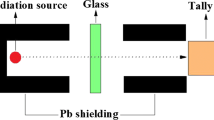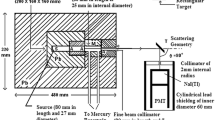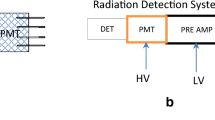Abstract
Background
Radiation detection has been a main interest for researchers as all kind of produced particles in atomic and subatomic physics based on the measurement systems so-called detector. Detection efficiency is one of the main parameters in detection system besides many other different parameters of the detector. The detector in experimental physics is an instrument that converts radiation energy into an electrical signal, and this is achieved basically by either ionization or excitation. The choice for any type of a detector (gas-filled, scintillation or semiconductor) for any application depends upon the X-ray of gamma energy range of interest. A working model is therefore developed which is capable of describing the overall NaI(Tl) detection efficiency as a function of several known parameters.
Purpose
The attenuation coefficients for the bismuth borate glasses with different concentrations were measured using gamma spectroscopy technique. The numerical absolute efficiency calibration of a detector can be determined by In-Situ Object Calibration Software (ISOCS) and Monte Carlo Neutral Particle version 5 (MCNP5) techniques which does not require any calibration standards or reference materials.
Methods
By using the ISOCS and MCNP5 methodologies, the full energy peak efficiency of a scintillator detector (3“X3” NaI (Tl)) exposed to Co-60 and Cs-137 gamma ray sources with average accuracy range 0.126–1.224% for the used samples can be detected. The used materials are ternary and are located between the detector and the source to determine the attenuation coefficients for these samples by using the calculated full energy peak efficiencies of a detector.
Results
The average accuracy ranged from − 1.808 to 1.960% for linear attenuation coefficient (\(\mu \)), while it ranged from − 1.999 to 1.888% and from − 1.924 to 1.960% for half value layer (HVL) and mass linear attenuation coefficient (\(\mu _m\)), respectively.
Conclusion
The calculated values of the absolute full energy peak efficiency have been used to determine the attenuation coefficients of materials with different concentrations and different densities. The results proved the validation of ISOCS and MCNP to determine the absolute full energy peak efficiency of the detector which can be used to determine the attenuation coefficients for the simulated samples and it is a good tool to be used when experimental methods are not available.
Similar content being viewed by others
Avoid common mistakes on your manuscript.
Introduction
Gamma detection techniques are widely used in gamma spectroscopy for nuclear physics [1]. In particular, scintillation detectors have been widely used in many fields [2]. Radiation loses all or part of the energy by making interactions since enter into material environment. Excitation condition is a condition that exists for the atomic nucleus. Degradation of equilibrium in the nucleus causes the excitation. During the excitation, nucleus trend to return to the ground state. This trend is a natural process of nucleus and causes the radiation release which it is the basic principle of the detection. The detection systems most widely used for gamma spectrometry are NaI(Tl) and HPGe-based detectors [3, 4]. One of the most important characteristics of a detector is its efficiency. The most advantage of NaI(Tl) detector is its high efficiency with much lower cost [5, 6]. Detection efficiency definition covers some parameters as (i) absolute efficiency (ii) intrinsic efficiency (iii) full-energy peak efficiency (FEPE). The counting efficiency of scintillation detector [NaI (Tl) (\(2^{''}\times 2^{''}\))] has been calculated by Kadum et al. [7]. They calculated the gamma attenuation coefficients of natural radioisotopes and their daughters to find the three components such as linear attenuation coefficient, mass linear attenuation coefficient and half-value layer of counting efficiency.
The Monte Carlo Neutral Particle version 5 (MCNP5) method has been used to calculate the photon detection efficiency and energy resolution curves for a scintillator detector [\(1.5^{''}\times 1^{''}\) NaI (Tl)] by Salgado et al. [8]. The detector has been exposed to gamma rays in the energy range from 20 to 662 keV, and the results showed good agreement with the experimental data. An efficient Monte Carlo computer program for simulation and calculation of the total and full-energy peak efficiency (absolute and intrinsic) of the cylindrical NaI (Tl) detector (with different: volumes, source-detector distances and gamma ray energies) has been described by Kadhem et al. [9]. They showed quite well agreement with experimental data and with other calculations within an error \(\le \) 2%. Their results can be used in gamma spectroscopy and determining the activity of sources.
The absolute efficiency of the used gamma detector system in Turkish Accelerator and Radiation Laboratory at Ankara (TARLA) was simulated using MCNPX code (version 2.4.0); the results have been obtained for NaI(Tl) detector system and compared with the experimental results. A good agreement was found between calculated and experimental results [10]. The variation of the intrinsic efficiency of the NaI(Tl) detector against the source-detector distance has been calculated by Mowlavi et al. [11] for different gamma ray energy using MCNP5 code. Venkataraman et al. [12] have been determined the full-energy peak efficiency of a germanium detector in the 0.045–7 MeV energy range, for any practical source matrix and geometry. They used mathematical techniques as In Situ Object Calibration Software (ISOCS) and LabSOCS which have undergone significant improvements and enhancements. In this method, the detector response was characterized by creating a set of fine spatial efficiency grids at 15 energies in the 0.045–7 MeV range. The spatial grids are created in (\(r,\theta \)) space about the detector, with the radius r varies from 0 to 500 m, and the angle \(\theta \) varying from 0\(^{\circ }\) to 180\(^{\circ }\). The reference efficiencies for creating the spatial grids are determined from MCNP5 calculations using a validated detector model. Once the efficiency grids are created, the detector response can be determined at any arbitrary point within a sphere of 500 m radius and at any arbitrary energy within the specified range [12].
The ISOCS modeling software allows performing absolute efficiency calibration for items of arbitrary container shape and wall material, matrix chemical composition, material full-height, uranium or plutonium weight fraction inside the matrix and even nuclear material/matrix with nonhomogeneous distribution. Furthermore, in a number of cases, some key parameters such as matrix density and U/Pu weight fraction can be determined along with analysis of nuclear material mass and isotopic composition. These capabilities provide a verification solution suitable for a majority of cases where the quantitative and isotopic analysis should be performed [13].
Model-based methods have been used to calibrate nondestructive systems to characterize wastes contaminated with plutonium, uranium, and other radioactive isotopes. Model-based measurement methods, such as the In Situ Object Calibration Software (ISOCS), make use of knowledge of the measurement configuration to establish calibration parameters. Model-based measurement approach has been used for a variety of purposes at Oak Ridge National Laboratory (ORNL) including LLW/transuranic (TRU) sorting of a wide variety of radio-nuclides and waste streams in 55 gallons and over-pack drums [14].
The photon attenuation coefficient is an important parameter for characterizing the penetration and diffusion of X-rays and gamma rays in multi-element materials. The photon attenuation coefficient is required in a variety of nuclear science, technology and medical applications. The fact that radiation could be harmful, so there will be a great need for the development of a wide variety of shields to protect against it. The attenuation coefficient measures the probability of all possible interactions between gamma rays and atomic nuclei. It depends on the incident photon energy and the nature of the absorbing material. It is important for solving various problems in radiation physics and in radiation dosimetry. Moreover, several authors investigated the shielding properties of different materials at different energies [15,16,17,18,19,20,21,22,23].
In this work, MCNP5 and ISOCS techniques have been used to calculate the absolute full-energy peak efficiency of the detector for different energies. In addition, an application includes the calculated efficiencies have been used to determine the attenuation coefficients for some bismuth borate glasses with different concentrations to determine the best concentration which can serve as gamma shielding material.
Simulation work
MCNP5 is a computerized mathematical technique capable of solving complicated three-dimensional problems. This code is based on the use of random numbers to investigate a statistical process such as the interaction of radiation of photon, electron, neutron or coupled photon/electron/neutron with materials. The used energy ranges for neutron interaction with materials expanded are from 10 or 11 to 20 MeV. For photon and electron energy are 1 keV–1000 MeV, respectively. A file comprises information about the material specification, the characteristic of geometry and choice of cross-sectional assessments, the location and features of the photon, electron or neutron source, the kind of answers or desired tallies and any variance reduction methods used to increase efficiency can be provided to the code [25]. On the other hand, the ISOCS software brings the possibility to establish an absolute efficiency curve for a desired energy range based on numerical simulation with the use of known or guessed geometry and chemical composition of measured item. The software provides a variety of geometry templates which covers a wide range of possible item shapes such as cylinders, pipes, boxes as well as more complex geometries. This approach can save purchasing, transport, track and dispose calibration sources and time [13]. The ISOCS detector characterization method uses mathematical techniques to determine the gamma ray full-energy peak efficiency of detectors, in vacuum, at an arbitrary energy and spatial location within the characterization range. The response characterization is used by the ISOCS software package, which factors in the attenuation through any absorbing materials that may be present between the source point and the detector.
Therefore, two groups of some bismuth borate glasses [24] with different concentrations and different densities have been simulated. The simulated samples have a rectangular shape with 6.98 cm length, 4.7 cm width and 1 cm thickness. The chemical formula and density of the simulated samples are listed in Table 1.
Each sample was simulated in such a way that its axis of symmetry is perpendicular to the extended axis of symmetry of the NaI detector in front of the source in both ISOCS and MCNP5 calculations. In this calculations, the distance between the source and the Al cap of the detector is 10 cm and the sample placed between the source and the detector with different concentration in 1 cm thickness. The accuracy was calculated using the equation;
where X is the physical parameters such as \(\mu , \mu _{\mathrm{m}}\), and so on.
Results and discussion
In the first part of efficiency calculations, MCNP5 code is used to perform numerical simulations for measurements, taking into consideration the energy of the emitted gamma ray. MCNP5 input files contain detailed characteristics of the detector’s dimensions, sample’s dimensions and the experimental setup configuration to calculate the absolute full-energy peak efficiency of the detector at a certain sample-detector distance.
The MCNP5 code has been used for modeling the detector response, since it contains a tally, F8, which is specific for detector pulse height determination. The fraction of gamma ray with certain energy absorbed in the detector active volume represents its absolute full-energy peak efficiency in this energy. Forty-two files as input for MCNP5 are designed for every energy line to perform the calculations for the first and second group samples. The number of histories was selected to keep the relative standard deviation due to MCNP5 calculations less than 2%. Each run of calculation was performed using \(6\times 10^{6}\) number of histories. Tables 2, 3 and 4 present the results of MCNP5 calculations for the absolute full-energy peak efficiency at energies 661.7, 1172.3 and 1332.5 keV, respectively, for the two groups.
Using the ISOCS methodology, one can determine the full-energy peak efficiencies of a detector in the 661.7, 1173.2 and 1332.5 keV. The results of ISOCS calculations for energy lines 661.7, 11723.2 and 1332.5 keV are included also in Tables 2, 3 and 4.
Comparisons between the calculated absolute full-energy peak efficiencies by MCNP and ISOCS techniques at energies 661.7, 1172.3 and 1332.5 keV are shown in Fig. 1. It can be seen that, the absolute full-energy peak efficiency of the detector is higher at low source energies and decreases as the energy increases. The linear attenuation coefficients of the samples have been calculated, using the calculated efficiencies, to determine the best concentration for using as a gamma shielding material. Figure 2 shows the linear attenuation coefficient \((\mu )\) determined by MCNP and ISOCS techniques for the two groups of the samples at different energies.
The half-value layer (HVL) is the required thickness of a material to reduce the intensity of the emergent radiation to half. It is used to describe the effectiveness of gamma ray shielding [26] as;
Therefore, once one knows the linear attenuation coefficient of a material, the half-thickness can be readily calculated. Figure 3 illustrates a comparison between the values of HVL which were determined by MCNP and ISOCS at studied energies.
The mass attenuation coefficient \((\mu _{\mathrm{m}})\) was determined by dividing the linear attenuation coefficient to the sample density. Tables 5, 6 and 7 summarizes the mass attenuation \((\mu _{\mathrm{m}})\) coefficients were calculated by ISOCS and MCNP techniques at the studied energies for the verified samples.
The results obtained in this work have shown acceptable values in comparison with two techniques. Results indicate the ISOCS and MCNP are valid to determine the absolute full-energy peak efficiency of the detector which used to determine the attenuation coefficients for the simulated samples.
Conclusion
In the present work, the absolute full-energy peak efficiency has been calculated for \(3^{''}\times 3^{''}\) NaI (Tl) detector by MCNP and ISOCS techniques for different energies. The calculated values of the absolute full-energy peak efficiency have been used to determine the attenuation coefficients of material with different concentration and different density. The results proved the validation of ISOCS and MCNP to determine the absolute full-energy peak efficiency of the detector which can be used to determine the attenuation coefficients for the simulated samples and, it is a good tool to be used when experimental methods are not available. This work may be extended to other types of detectors and other types of materials with different concentration, thickness and density. The proposed method becomes very useful to determine the attenuation coefficients for different types of materials without preparation and determine the best concentration and the best thickness required.
References
D.J. Wagenaar, S. Chowdhury, J.C. Engdahl, D.D. Burckhardt, Nucl. Inst. Methods Phys. Res. A 505, 586 (2003)
M. Moszynski, Nucl. Inst. Methods A 505, 101 (2003)
M. Ahmadi, M. Rabbani, P. Mir Ahmadpour, J. Appl. Chem. Res. (JACR) 3, 55 (2009)
J. Kaneko, M. Katagiri, Y. Ikeda, T. Nishitani, in Proceedings of the 12th Workshop on Radiation Detectors and Their Uses (KEK, Tsukuba (1998), p. 98
G.F. Knoll, Radiation Detection and Measurement (Wiley, New York, 2000)
J. Eberth, J. Simpson, Prog. Part Nucl. Phys. 60, 283 (2008)
A. Kadum, B. Dahmani, Int. J. Technol. Enhanc. Emerg. Eng. Res. 2, 2347 (2014)
C.M. Salgado, L.E.B. Brandão, R. Schirru, C.M.N.A. Pereira, C.C. Conti, Prog. Nucl. Energy 59, p19 (2012)
A.B. Kadhem, A.N. Mohammed, Eng. Tech. J. 28(5), 1001 (2010)
I. Akkurta, H.O. Tekinb, A. Mesbahi, in International Conference of Computational and Experimental Science and Engineering, Kemer, Antalya, Turkey, vol. 128 (2015)
A.A. Mowlavi, R. Izadi Najafabadi, R. Koohi Faygh, Int. J. Pure Appl. Phys. 1, 129 (2005)
R. Venkataraman, F. Bronson, V. Atrashkevich, M. Field, B.M. Young, J. Radioanal. Nucl. Chem. 264, 213 (2005)
V. Nizhnik, E. Braverman, A. Lebrun, F. Rorif, IAEA-CN-184/047, IAEA, Vienna, Austria
J. Wachter, K. Meyer, Sean Stanfield and Robert Ceo WM2014 Conference, March 2–6, Arizona, USA, Phoenix (2014)
I. Akkurt, H. Akyildirim, B. Mavi, S. Kilincarslan, C. Basyigit, Ann. Nucl. Energy 37–7, 910 (2010a)
I. Akkurt, H. Akyildirim, B. Mavi, S. Kilincarslan, C. Basyigit, Prog. Nucl. Energy 52, 620 (2010b)
N. Damla, U. Cevik, Al Kobya, A. Celik, N. Celik, R. Van Grieken, J. Hazard. Mater. 176, 644 (2010)
G. Eduardo, L. Alfredo, Héctor René Vega-Carrillo, Nucl. Technol. 168(2), p399 (2009)
M. Kurudirek, I. Turkmen, Y. Ozdemir, Radiat. Phys. Chem. 78, p751 (2009)
K.S. Mann, M. Kurudirek, G.S. Sidhu, Appl. Radiat. Isot. 70, 681 (2012)
K.S. Mann, S.Gurdeeps Sidhu, Ann. Nucl. Energy 40, 241 (2012)
K.S. Mann, T. Korkut, Ann. Nucl. Energy 51, 81 (2013)
I. Turkmen, Y. Özdemir, M. Kurudirek, F. Demir, Ö. Simsek, Demirbog. Ann. Nucl. Energy 35, 937 (2008)
H. Doweidar, Yasser B. Saddeek, J. Non-Cryst. Solids 355,p, 348 (2009)
X-5 Monte Carlo Team, MCNP—A General Monte Carlo N-Particle Transport Code, Version 5 (2003)
H.A. Saudi, A.G. Mostafa, N. Sheta, S.U.El. Kameesy, H.A. Sallam, Phys. B: Condens. Matter 406, 4001 (2011)
Author information
Authors and Affiliations
Corresponding author
Rights and permissions
About this article
Cite this article
El-Haseib, A.Y., Ahmed, Z. & Saddeek, Y.B. Determination of gamma ray spectrometry efficiency for the attenuation coefficients of some bismuth borate glasses by MCNP and (ISOCS) techniques. Radiat Detect Technol Methods 2, 40 (2018). https://doi.org/10.1007/s41605-018-0069-8
Received:
Revised:
Accepted:
Published:
DOI: https://doi.org/10.1007/s41605-018-0069-8







